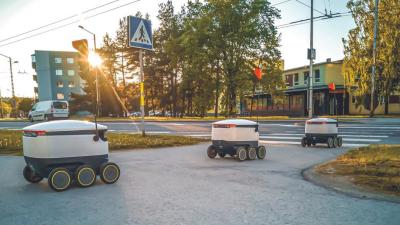- Support portal
- Evaluation Kits and partner products
u-blox Support
- Product documentation
Documentation
- Investor relations
Investor relations
Insights
|
08 Nov 2021
5G for UAVs: More than a high-speed data pipe
As UAVs gain traction in cities, they will push positioning and communication technologies to their limits. There’s a lot 5G will be able to offer to drones.

It’s has become almost impossible to conjure up an image of the city of the future without picturing drones hovering in the air and unmanned autonomous vehicles roaming the streets and sidewalks. Potential applications abound, with the aerial delivery of consumer goods and vital medicines, traffic, infrastructure, and pollution monitoring, and surveillance. On the ground, autonomous robots can deliver food and parcels, offer public services such as tourist information, and safety and healthcare services. Not to mention the myriad opportunities they present for entertainment, retail, and advertising.
It’s an exciting prospect that is inching closer to reality year to year, with Coherent Market Insights projecting the Robots as a Service market to reach US$ 41.3 billion by 2028. But for these use cases to take hold, the drones and ground robots will need to comply with regulations that policymakers have yet to draft, in order to ensure that they add value to the urban residents they serve, and don’t wind clogging busy sidewalks or otherwise becoming a nuisance.
A technological to-do list
From a technological perspective, several challenges remain. Until they become fully autonomous, drones and UAVs will need to be remote-controlled. While, today, remotely operated drones need to remain within line of sight of the pilot – with direct wireless communication between the pilot and the vehicle, the applications listed in the introduction will likely require operation beyond visual line of sight (BVLOS).
To be controlled reliably, their communication link from the operator to the vehicle will need to be relayed via a network, with very low latency. At the same time, drones deployed for monitoring applications, for instance, will need a high-bandwidth data pipe to transmit high resolution images back to the cloud for analysis.
The challenges extend to positioning as well. The very environments most likely to see a surge in aerial and ground robots will push positioning solutions, in particular those based on global navigation satellite systems (GNSS), to their limits. Surrounded by tall buildings, the UAVs will depend on their multi-constellation GNSS receivers, to continuously “see” enough GNSS satellites to determine their position.
Their inertial measurement units, made up of gyroscopes and accelerometers, will be relied on to bridge interruptions in GNSS reception. And their multi-band receivers with RTK technology combined with a growing suite of GNSS augmentation services will make reliable centimeter-level positioning accuracy a reality, almost all the time.
5G for UAVs: Low latency, high bandwidth, hybrid positioning
But, because the urban topography is complex, not all the time. Today, ground robots typically navigate using a satellite-based positioning – still the only source of absolute position information – complemented with visual sensors, and a digital map. Because GNSS technology can, in some scenarios, become unreliable, they would benefit from a complementary, secondary source of absolute position technology to serve as a fallback. Ideally, that technology would be able to serve multiple purposes on the drones and leverage already existing infrastructure to simplify deployment and adoption.
Once fully deployed, 5G will have the potential to tick all the boxes in this technological to-do list. The fifth generation of cellular communication technology comprises a suite of technologies that serve multiple use cases. Two are particularly relevant for UAVs: Enhanced mobile broadband (eMBB) for high speed data transfer, and ultra-reliable low latency communication (uRLLC) for reliable remote control of drones and ground vehicles via the cellular network, well beyond visual line of sight.
At the same time, 5G will pave the way for high precision cellular network-based positioning. Offering larger bandwidths than 4G LTE will allow 5G to improve the performance of cellular-based positioning. The larger bandwidth will make it possible to better resolve multipath effects, which are a common cause of positioning errors in urban settings.
In 5G deployments at higher frequencies, designed to offer even larger bandwidths, signals propagate less far than today’s cellular signals, and mobile network operators will need to deploy more base stations to guarantee coverage. Combined with the introduction of antenna arrays with beamforming capabilities, these improvements will offer a complementary source of high precision positioning to support GNSS-based positioning.
To explore the potential of 5G networks to support traditional navigation methods for UAVs, we will participate in a joint project with CGI, ESA, the Advanced Communication, Mobile Technology and IoT (ACMI) Research Centre at the University of Sussex and air navigation service provider NATS. The aim of the project will include defining use cases and system requirements for a 5G-based complement to existing GNSS receivers. We look forward to contributing our experience in GNSS and high precision positioning to this exciting project.
Chris Hide
Senior Principal Engineer, Positioning Technology




